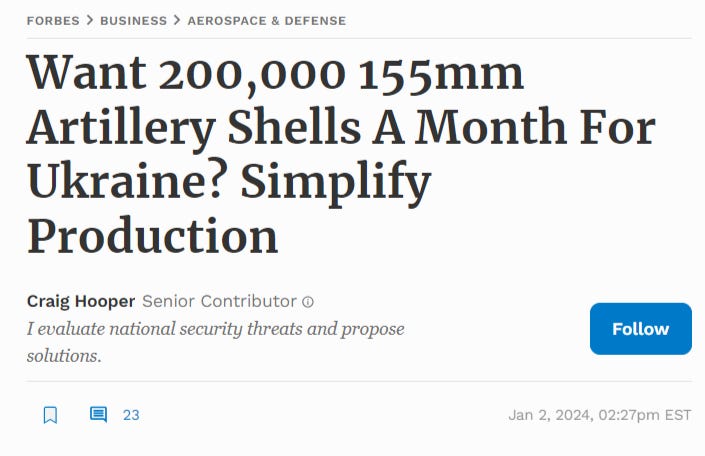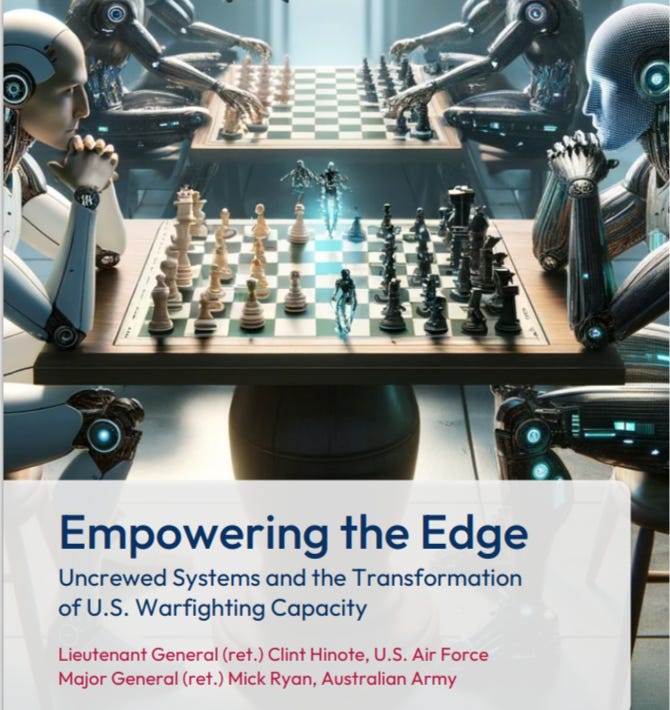The Future of the SMO [Part 2]
Note: I have decided to make the final, most important part of the analysis, which will revolve around the coming Russian offensive strategies, free in an upcoming regular article. I was going to include it here, but realized the information is too important and should be widely accessible. So, this article will continue the series via the promised think tank analyses and an introduction section on Russia’s upcoming strategy, but stay tuned for the full continuation.
The present article is another large 7,500+ word one, and I have left about 1,000 of that as free preview.
US Turns Its Eyes on Future
The US and NATO allies are hard at work at re-envisioning their own battlefield priorities in light of the revolution being witnessed in the Ukrainian war. Think tanks are churning out piece after piece, with the latest offering from Substack’s own retired Major General Mick Ryan of the Australian Army and Lt. General S. Clinton Hinote of the US Air Force:
They start off with the one major admission necessitating this very paper—that the Western edge has not only been eroded, but rapidly so:
During the post-Cold War era, for example, several one-sided battlefield contests occurred where Allied militaries quickly dominated adversaries stuck in older paradigms.
Unfortunately, this advantage—what some have called “overmatch”—has eroded, and has done so rapidly. As the U.S. competition with China and Russia grows, we seek new ways of fighting.
They move directly into another powerful confirmation of something we’ve long discussed here apropos the differences between Western and Russian military systems. Couching it in self-serving terms of seeking ultimate ‘protection’ for troops, they admit that Western systems have gotten so expensive that their operators are afraid to even use them—defeating the whole point of warfighting equipment:
Western minds have taken a long time to come to conclusions drawn by Russia ages ago, and by us here in articles like the following, which expounded on precisely this disparity in the warfighting principles between Russia and the West:
In The Spirit Of Russian 'Total War'
An important distinction has been long overdue in the making, as pertains to a topic of much confusion and misinterpretation to a great many people. There’s an inherent misconception about the conceptual differences between Soviet/Russian military systems (read: weapons) and those of NATO/Western equivalents. Endless debate has been made not only about w…
Mick and co. clearly have Yemen and Iran in mind as well when they go on to write the following:
Our competitors know this; they have spent two decades developing sensors and weapons designed to find and destroy these costly assets. Relatively cheaper technologies that make exquisite modern weapons vulnerable have proliferated to our potential adversaries. This is the definition of cost imposition, and we have been on the wrong side for many years.
As a brief aside on this topic, it’s remarkable how much the narrative is shifting in this direction. Almost every thing the West once skewered Russia for, they are now fumbling to adapt into their own doctrines. Top military figures from both the UK and US have recently urged the re-establishment of national conscription, i.e. compulsory service, belatedly realizing that an “all volunteer force” is simply not feasible.
Similarly, the tune has now changed on ‘premium’ weaponry. This recent Forbes article from last month makes an absolutely stunning argument:

To eke the maximum safety, shelf-life, and performance out of each and every shell, Western artillery ammunition is over-engineered—and then, on top of already daunting engineering requirements, the shells are subjected to an array of boutique national requirements.
Having each Western shell lovingly crafted to the exacting tolerances of a Formula 1 race-car engine offers measurable benefit. In ideal circumstances, Allied artillery systems outrange, outfire and hit harder than equivalent Russian systems. But conditions are no longer as ideal.
In short: they argue that Western artillery shells are over-engineered and should be stripped of their tedious quality control measures to favor ‘quantity’ over ‘quality’ instead. Interesting proposition!
Put another way, precision ammunition machining doesn’t make much difference when the shell goes up an overused gun barrel that, in peacetime, would have long been consigned to the scrapheap thousands of shells ago.
They add that, in essence, Western military engineering is made for peacetime conditions—in real war conditions, a totally new rough-and-tumble ethos must be adopted. Where have we heard that before? Recall my article pasted above, which speaks precisely of that philosophical clash, and how Russia had already long learned the lesson having been habituated to real existential Total Wars on its territory, rather than the predatory wars of opportunity the West is accustomed to waging.
The article finishes with:
Cherished rice bowls will break. Old, longstanding methods may go away. But, right now, the overarching priority—at least for general purpose artillery ammunition—is lower price and greater speed.
Anything less helps Russia.
If that wasn’t remarkable enough, last week’s new interview with popular pro-UA podcaster-analyst from Australia, military veteran William OAM, emphasized this point even more urgently:
“Do we need the quality? Or do we just need the fuckin’ quantity?”
He goes on to argue that 5000 “shitty North Korean shells” do more damage than 100 “fantastic” American ones, manufactured with loving care to industry-leading tolerances. The fact is, the West tailor-made their modern showroom armies for specifically fighting localized, controlled conflicts against very limited Middle Eastern opponents. In a true Total War scenario, no country on the planet has the manufacturing capacity or resource supply chains to produce the gargantuan amounts of “smart munitions” necessary for serious long-haul warfare against near-peer adversaries.
You can sense the desperation in the West as the realities begin to dawn on their leading thinkers. Years of building showroom ‘good-weather’ armies meant to impress buyers at MIC-enabled arms expos have left Western military doctrines woefully out of date concerning how real wars are fought.
Keep reading with a 7-day free trial
Subscribe to Simplicius's Garden of Knowledge to keep reading this post and get 7 days of free access to the full post archives.






